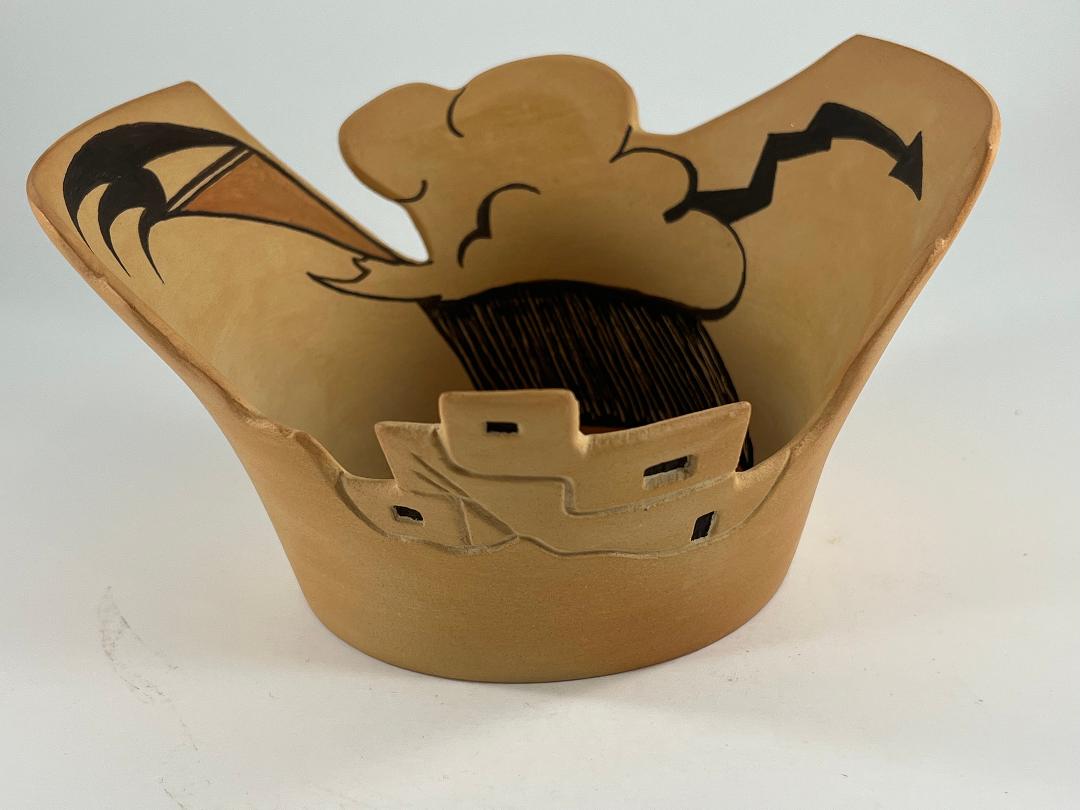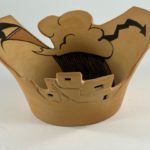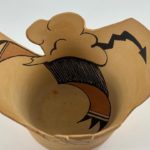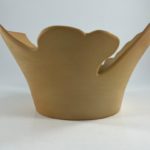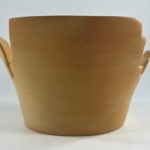This pot has a unique shape and a realistic design crafted to fit that shape.. More than any other pot in the collection, form and design work together to create an explicit visual story. I’m enchanted; Les does not remember making the pot. Les is a popular and prolific potter whose style has dramatically evolved over the last 30 years. Currently he kiln-fires his pots and paints with acrylic paint, layering his abstract designs. His work is very distinctive and eagerly sought by collectors, none of whom would recognize pot 2021-15 as being his work.
Form:
From a 6-inch bottom the walls expand outward about 4 inches to the edge. The walls of this pot are extremely thin; the edge of the pot almost sharp. The walls are so thin that the pots seems to have no weight. While the clay was wet Les carved away two sections of the wall directly opposite each other. He left one of these sections with a terraced edge, the other has rounded edges. The surface of the pot was not finished with a polishing stone but has a matte finish. When struck with a finger the pot emits a high-pitched sound, evidence of kiln firing.
Design:
The outside of the pot is undecorated, except for the terraced section. Here Les took a sharp implement and inscribed the outline of a three-storied pueblo dwelling, including four windows. The windows are painted black, the only paint on the exterior of the bowl. The interior of the bowl carries a more extensive design. On the interior, directly opposite the terraced edge, Les painted a towering thunderhead, its upper edge the rounded edge of the pot. The cloud issues a black bolt of lightening to the right and an avian wing to the left. Rain pours from its lower edge. As the rain hits the floor of the pot it forms another avian wing.
Both wings have a red cone-shaped bodies. The wing near the edge of the pot has two parallel black lines that mark the blunt end of its curved red base. The design is then caped by a curved black claw with three long nails, also curved. Inset into the base of this black form is an unpainted area roughly the shape of an arrowhead. The second avain wing, on the floor of the pot, also has a curved red cone -shaped base. It is capped by four parallel lines, forming a “three-lane highway.” The middle lane is painted black. This wing terminates with three curved isosceles triangles, also claw-like.
Design analysis:
When we see a bowl, the first thing we do is look down at the interior to see the design. That’s not the perspective suggested by bowl 2021-15. The story of this bowl is told from the outside looking through the windows of the terraced dwelling at the roaring storm outside the home. An inch-tall person on the exterior of the bowl looking through the black windows at the bowl’s interior would have the correct perspective.
Birds carry the prayers of pueblo people asking the gods for rain, hence the avian iconography. The windows of the terraced dwelling are black because they are looking at the dark thunderhead outside. Here the prayers have been dramatically answered, as great torrents of rain flood the Hopi mesas. Rain clouds are a frequent design on pottery made at Hopi and usually have a specific abstracted form (see 2001-04, 2012-05). The realistic cloud on this pot is outside that tradition.
Bowl 2021-15 suggests a story.
There’s a tale told at Santa Clara Pueblo about a terrible drought and a boy who followed a bear to water, thus saving his village. The southwest is currently experiencing its worst drought in 1,200 years. I imagine the view from this pot being the start of a Hopi tale about a child who looked out her window and saw rain clouds when others saw only clear sky. Although it was not the katchina season, the child eventually convinces her parents and the village elders that the correct ceremonies need to be performed to welcome the rain. The ceremonies are performed, the prayers are answered, and rain comes. The drought ends, corn plants drink and grow. The people live in bounty because of the vision of the little girl, the vision of this bowl.
Yea, I know that makes me a romantic (or childish), but I like this pot and the story that flows from it.

